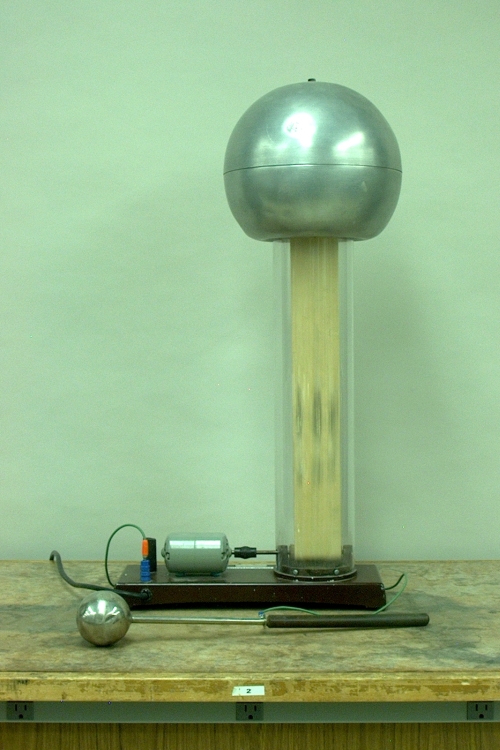
A video of this demonstration is available at this link.
With the Van de Graaff generator on, bring the spherical end of the (grounded) wand close (a few inches) to the sphere of the generator to cause breakdown of the air between the generator and the wand, producing impressive sparks. The two heat lamps pictured at right remove moisture from the surrounding air, reducing the tendency for charge to leak from charged objects into the air, which would reduce the potential to which the generator charges the sphere. The wand must be grounded, either via the jack on the base of the Van de Graff generator (blue protuberance near the line cord) or directly through the ground hole in one of the table outlets. Important! Always use the grounded wand to turn the generator on and off.
This interesting and ingenious device works by a combination of induction, corona discharge and mechanical motion.
Inside the Van de Graaff generator is a rubber belt, which is stretched over two rollers. At the bottom is the drive roller, which is connected to the motor. In the generator shown above, the drive roller is coated with felt, and the upper roller is naked plastic. A comb of sharply pointed pins sits adjacent to each roller. As the drive roller turns, by friction it charges the inside of the belt positive, which induces a negative charge on the bottom comb, which is grounded. The comb then sprays electrons onto the outside surface of the belt by means of corona discharge (see 56.54 -- Lightning rod), giving it a negative charge. The belt carries this negative charge up to the top comb, which via corona discharge pulls electrons off the moving belt and deposits them onto the large aluminum sphere. (Which sign this charge has depends on the materials of which the pulleys and the belt are made, specifically, where they lie in relation to each other on the triboelectric series.)
The Van de Graaff generator charges its metal sphere to a high potential (proportional to the amount of charge on it). If the potential of the sphere is high enough, when you bring the grounded ball wand within a few inches of it, the air between the sphere and the wand “breaks down,” and the sphere discharges castastrophically in an arc. In air, there are always a few electrons, either from cosmic ray bombardment or natural radioactivity. Breakdown occurs when the electric field is large enough that within their mean free path, these electrons can gain enough energy to ionize the gas molecules with which they collide. The positive ions thus formed are then accelerated in the opposite direction to the electrons and collisionally excite, and undergo charge exchange with, other air molecules. Some strike the dome of the van de Graaff generator (if it is negative; if it is positive, they strike the wand) with enough energy to eject secondary electrons, which ionize more gas molecules. Some of the ions recombine with electrons, and others ionize other gas molecules via charge exchange. The result is the formation of a conductive path from the sphere of the Van de Graaff generator to the ground wand, through which the sphere of the Van de Graaff generator quickly discharges. The light we see is emission from electronically excited molecules (either collisionally excited or formed by ions that have recaptured electrons) relaxing to lower energy levels, and the crack is the shock wave formed by the rapid expansion of the air that has been suddenly heated by the arc.
The voltage necessary to cause electrical breakdown across an air gap depends on the air pressure, humidity, distance between the electrodes, and also the shape of the electrodes. The machine in this demonstration is capable of achieving voltages on the order of about 250,000 volts, and producing arcs of up to about eight inches long. This voltage is rather impressive, and a person who discharged the generator by touching the dome would feel a strong shock. The capacitance of the generator (q/V, the amount of charge per volt of electrical potential developed on the dome), however, is very small. The charge on the dome is thus small enough that, unless a person has a medical condition that would cause sensitivity to such things, neither the current nor the total energy delivered in a discharge is enough to cause injury.